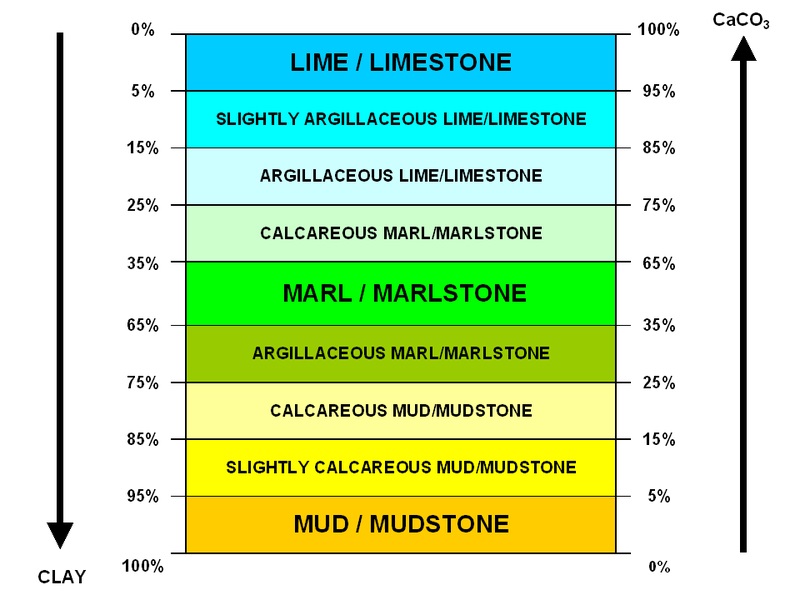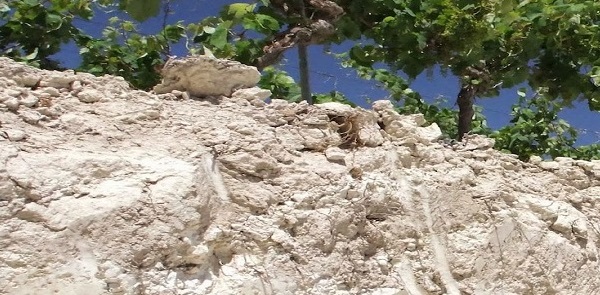Sedimentary Soils

Sedimentary soils are composed from pieces of rock, sand, silt, clay, seashells, skeletons, and many other types of organic deposits created as layers in lakes, rivers, and in the sea.

Lime accumulate under pressure to
Limestone
Sand accumulate under pressure to
Sandstone
Marl accumulate under pressure to
Marlstone.
Mud accumulate under pressure to
Mudstone
Different Limestone Types

- Chalk
- Kimmeridgian Limestone
- Calcareous Clay
- Marl
- Dolomitic Limestone
- Albariza Limestone
Each terroir type imparts properties to the soil, affecting water retention, drainage, mineral content, and influence the vine health and the grape characteristics.
The proportion of each type contributes to the a unique terroir of each vineyard.
Chalk
Chalk is a very porous and soft limestone.

Chalk soils are rich in calcium carbonate and have a high pH. They provide excellent drainage and are often associated with high-quality wines.
Chalk is a porous limestone that vine roots can easily penetrate. Chalky soils works best for grapes with high acidity levels, and can impart minerality to the grapes, contributing to the wine's complexity.
Best known Regions:
- Champagne (France)
- Chenin in Loire (France)
Kimmeridgian Limestone
Kimmeridgian soil is gray limestone soil originally identified in Kimmeridge in England.
It is composed of clay and fossilized oyster shells.

During the Kimmeridgian age (150 million years ago), warm sea led to an accumulation of carbonate deposits mixing with terrestrial erosion elements, such as clay. This explains the presence of marl oyster fossils in Kimmeridgian soils.
Best known Regions:
- Champagne (France)
- Chablis (Burgundy, France)
- Sancerre (Loire, France)
- Pouilly-Fumé (Loire, France)
- Alsace (France)
- Saint-Emilion (Bordeaux, France)
- Toscana (Italy)
- Puglia (Italy)
Calcareous
Calcareous is an adjective meaning "mostly or partly composed of calcium carbonate", in other words, containing lime or being chalky. The term is used for a wide variety of vineyard soils:
| Name | Description |
|---|---|
| Calcareous Clay | Clay soil with high limestone content. |
| Marl | A calcareous-clay-based combination of limestone and clay. |
| Kimmeridgian marl | Calcareous clay with Kimmeridgian limestone (fossilized oysters). |
Calcareous Clay
Calcareous soil is alkaline soil with high levels of calcium and magnesium carbonate. It is typically cool in temperature and provides good water retention and drainage.
Calcareous clay soils have high limestone content, which neutralizes the natural acidity of the soil. However, the cool temperatures of the soil normally delay ripening in the grape, which tends to produce more acidic wines.
Marl

Marl is a calcareous-clay-based combination of limestone and clay.
Marl adds acidity to wine, and vines planted in Marl soil normally ripen later than in other soil types.
Marl is found in Burgundy (France) especially in the Côte d'Or region, where it provides a fertile base for Pinot Noir and Chardonnay.
Alsace represents a mosaic of vineyard soils from limestone to marl, clay-marl, marl-limestone, granitic, schist, sandstone, loess and alluvial soils.
Marl is the main soil type in the Piedmont wine region of Italy.
Kimmeridgian Marl
Kimmeridgian marl is calcareous clay with Kimmeridgian limestone.
The rock comes from the sea, and is rich in fossilized oysters.

While working in Dorset near the town of Kimmeridge in the south of England, French geologist Alcide d'Obigny, identified a unique layer of dark marl which he named Kimmeridgian. The layer runs from the North Sea to the Paris Basin.
Mudstone

Mudstone is a fine-grained sedimentary rock that plays a crucial role in vineyard soils by contributing to water retention, nutrient availability, and imparting a potential mineral character to the wine.
Mudstone, which is essentially ancient, consolidated mud (a mixture of silt and clay particles), forms an argillaceous (clay-based) soil. Its key characteristics and impact on viticulture include:
Best known Regions:
Marlborough (New Zealand)
Greywacke, which includes layers of mudstone, is common here, contributing to the region's famous Sauvignon Blancs.Chianti Classico (Italy)
The specific local soil type called galestro is a schistous (flaky) clay/mudstone that crumbles easily and is associated with characterful Sangiovese wines.Chablis (France)
The famous Kimmeridgian soils in Chablis are a type of grey marl (a lime-rich mudstone) that contributes to the unique subtle, mineral character of its Chardonnay wines.Paso Robles (California)
Various marine sedimentary rocks, including mudstone and calcareous shales, are found here and contribute to the region's diverse terroir.Germany and South Africa
Mudstone-containing soils are also found in vineyards in Germany and South Africa.
Sandstone
Sandstone is a sedimentary rock composed of sand particles formed to stones by pressure.

Best known Regions:
- Alsace (France)
- Chianti (Italy)
Cambrian Greenstone
Cambrian greenstone soils (unique to the area Heathcote in Australia) are recognised as some the world's oldest soils.
Formed by underground volcanoes 600 million years ago, these ancient soils are highly rich in minerals that form the building blocks for the molecules of colour and flavour in red wine.
